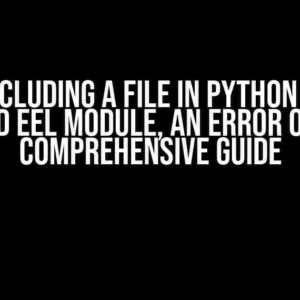Are you baffled by the enigmatic “None” value returned by your Python function? Do you find yourself staring at the code, wondering what went wrong? Fear not, dear Python enthusiast, for we’re about to embark on a journey to uncover the mysteries of this pesky issue and provide you with the tools to tackle it head-on!
What does “None” mean in Python?
In Python, “None” is a built-in constant that represents the absence of a value or a null value. It’s the default return value of a function when it doesn’t explicitly return anything. Think of it as a placeholder that says, “Hey, I didn’t find anything useful to return, so I’ll just give you this instead!”
When does a function return “None”?
A function can return “None” in several scenarios:
- No explicit return statement: If a function doesn’t contain a return statement or doesn’t reach a return statement, it will automatically return “None”.
- Return statement without a value: If a function contains a return statement without a value, it will return “None”. For example,
def my_function(): return. - Function calls another function that returns “None”: If a function calls another function that returns “None”, the calling function will also return “None” unless it explicitly returns a value.
- Exception handling: If a function encounters an exception and doesn’t handle it properly, it might return “None” instead of propagating the error.
Why is my function returning “None”?
To troubleshoot why your function is returning “None”, follow these steps:
- Check for explicit return statements: Make sure your function has a return statement with a value. If it doesn’t, add one or modify the existing one to return the desired value.
- Verify function calls: If your function calls other functions, ensure those functions return a value instead of “None”. Use a debugger or print statements to inspect the return values.
- Handle exceptions properly: Use try-except blocks to catch and handle exceptions. This will prevent your function from returning “None” due to unhandled errors.
- Review function logic: Walk through your function’s logic step-by-step to identify any potential issues. Use print statements or a debugger to inspect variable values.
Common pitfalls to avoid
Here are some common mistakes that can lead to a function returning “None”:
- Forgetting to return a value: Omitting the return statement or not providing a value in the return statement.
- Using print instead of return: Printing the result instead of returning it, which leads to “None” being returned.
- Not handling edge cases: Failing to consider edge cases or special scenarios that might cause the function to return “None”.
- Incorrect function calls: Calling a function with incorrect arguments or without proper setup, resulting in “None” being returned.
Real-world examples and solutions
Let’s explore some real-world examples and their solutions:
Example 1: Forgetting to return a value
def add_numbers(a, b):
result = a + b
# missing return statement!
print(add_numbers(2, 3)) # Output: NoneSolution:
def add_numbers(a, b):
result = a + b
return result # explicit return statement
print(add_numbers(2, 3)) # Output: 5Example 2: Using print instead of return
def greet(name):
print("Hello, " + name)
result = greet("John")
print(result) # Output: NoneSolution:
def greet(name):
return "Hello, " + name # return the greeting instead of printing it
result = greet("John")
print(result) # Output: Hello, JohnExample 3: Not handling edge cases
def divide_numbers(a, b):
if b != 0:
return a / b
else:
# missing return statement or handling for edge case!
print(divide_numbers(10, 0)) # Output: NoneSolution:
def divide_numbers(a, b):
if b != 0:
return a / b
else:
return "Cannot divide by zero!" # handle edge case with a meaningful return value
print(divide_numbers(10, 0)) # Output: Cannot divide by zero!Best practices to avoid “None” returns
To write robust and maintainable code, follow these best practices:
- Always include explicit return statements: Clearly indicate what value your function should return.
- Handle edge cases and exceptions: Anticipate and handle unusual scenarios to prevent “None” returns.
- Use meaningful return values: Return values that make sense for your function’s purpose, such as a default value or an error message.
- Test your functions thoroughly: Verify that your functions return the expected values under different conditions.
| Error | Solution |
|---|---|
| Forgetting to return a value | Add an explicit return statement with a value. |
| Using print instead of return | Replace print statements with return statements. |
| Not handling edge cases | Handle edge cases with explicit return values or error messages. |
| Incorrect function calls | Verify function calls with correct arguments and setup. |
Conclusion
In this article, we’ve explored the mysteries of the “None” return value in Python and uncovered the common pitfalls that lead to it. By following the best practices and troubleshooting steps outlined above, you’ll be well-equipped to write robust and maintainable code that avoids the “None” trap. Remember, a well-written function is one that returns a meaningful value, not “None”!
So, the next time you encounter a function returning “None”, you’ll know exactly what to do. Happy coding, and may the “None” be with you – in a good way!
Frequently Asked Question
Get the lowdown on why your function is returning “None” and how to fix it!
Why does my function return “None” instead of the expected result?
This often happens when you don’t explicitly return a value from a function. In Python, if a function doesn’t encounter a `return` statement, it defaults to returning `None`. Make sure you’re using `return` statements correctly to get the desired output!
How do I debug a function that’s returning “None” unexpectedly?
Start by checking your function’s logic and ensuring that it’s correctly handling all possible scenarios. Add print statements or use a debugger to identify where the function is going wrong. You can also try returning intermediate values to see where the function is deviating from the expected path.
What’s the difference between `return None` and not using a `return` statement at all?
While both scenarios result in a function returning `None`, there’s a subtle difference. When you use `return None`, you’re explicitly indicating that the function should return `None`. If you don’t use a `return` statement, the function will implicitly return `None` due to Python’s default behavior.
Can I use `return None` to indicate an error or exception?
It’s generally not recommended to use `return None` to indicate an error or exception. Instead, consider raising an exception using `raise` statements or returning a specific error value that can be handled by the calling code. This helps to make your code more explicit and easier to debug.
How do I avoid returning “None” in a recursive function?
When writing recursive functions, make sure to include a base case that returns a value explicitly. Also, ensure that you’re correctly handling the recursive call’s return value and propagating it up the call stack. If you’re still getting `None` as a return value, review your function’s logic and check for any implicit returns.




